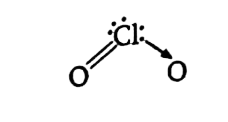Which of the following statement(s) is/are correct?
A
Chlorine dioxide is powerful oxidising agent but bleaching action is lower than
B
in alkaline solution undergoes disproportionation
C
is diamagnetic in nature
D
is a yellow gas but deep red liquid
Video Solution
Text Solution
The correct Answer is:B, D
is powerful oxidising agent, also strong chlorinating agent. Its bleaching power is almost 30 times stronger than alkaline solution undergoes disproportionation
 unpaired electron that's why paramagnetic.
unpaired electron that's why paramagnetic.
|
Topper's Solved these Questions
- p-BLOCK ELEMENTSBook:VK JAISWALChapter:p-BLOCK ELEMENTSExercise:MATCH THE COLUMN
Explore 24 Videos
- p-BLOCK ELEMENTSBook:VK JAISWALChapter:p-BLOCK ELEMENTSExercise:ASSERTION REASON TYPE QUESTIONS
Explore 27 Videos
- p-BLOCK ELEMENTSBook:VK JAISWALChapter:p-BLOCK ELEMENTSExercise:LEVEL 3 (PASSAGE TYPE)
Explore 20 Videos
- METALLURGYBook:VK JAISWALChapter:METALLURGYExercise:ASSERTION-REASON TYPE QUESTIONS
Explore 30 Videos
- PERIODIC PROPERTIESBook:VK JAISWALChapter:PERIODIC PROPERTIESExercise:ASSERTION-REASON TYPE QUESTIONS
Explore 35 Videos
Similar Questions
Knowledge Check
Which of the following statements(s) is/are correct?
AAldehydes are generally oxidised under vigorous conditionsBKetones are easily oxidised to carboxylic acids even under mild oxidising agentsCOxidation of ketone involves carbon-carbon bond cleavage to give a mixture of carboxylic acids having lesser number of carbon atoms than the parent ketonesDAll of the aboveWhich of the following statements (s) is/are correct ?
AIn an inertial frame Wconservative+Wnon-conservative+Wother -force=K2−K1BIn a non - inertial frame : Wconservative+Wnon conservative +Wother -force+Wpseudo - force =K2−K1CWork done by conservative forces is independent of path followed .DWork done by non - conservative forces depends on path followed .Which of the following statements (s) is/ are correct ?
AKetones are generally oxidised under vigorous conditionsBldehydes are easily oxidised to carboxylic acids even under mild oxidising agentsCOxidation ketone involes carbon-carbon bond cleaveage to give a mixture of carboxylic acids having lesser number of carbon atoms than the parent ketonesDAll of the above
Which of the following statements (s) is (are) correct?
View SolutionWhich of the following statements (s) is (are) correct?
View SolutionWhich of the following statements (s) is (are) correct?
View SolutionWhich of the following statements (s) is (are) correct?
View SolutionWhich of the following statements (s) is (are) correct?
View Solution

